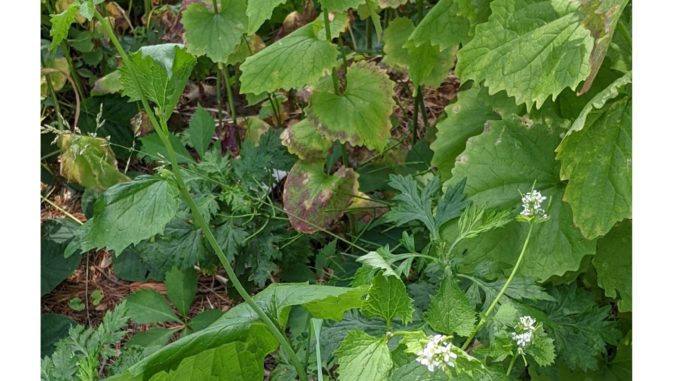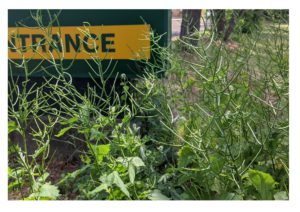
Like the “Englishman’s footstep” (Plantain – Plantago major), there is another invasive plant in our midst that we inadvertently spread via our footsteps. This plant is nearly ready to shed its multitude of tiny seeds onto the ground, where we and our animals pick them up and deposit them where they take foot and establish colonies along our trails, roads, and woods.
I am talking about garlic mustard, Alliaria petiolata.
 Garlic mustard plants start off the first year as a low-growing rosette. Those that survive the first year (only 2-4% — but that is more than enough!) go on to produce a taller plant that begins to flower in early spring. In late spring a seed head is produced that contains, per Google, between 165 and 868 seeds [and maybe ten times more!]. Somehow, the seeds lay dormant for an additional season, sprouting in the original plant’s fourth year.
Garlic mustard plants start off the first year as a low-growing rosette. Those that survive the first year (only 2-4% — but that is more than enough!) go on to produce a taller plant that begins to flower in early spring. In late spring a seed head is produced that contains, per Google, between 165 and 868 seeds [and maybe ten times more!]. Somehow, the seeds lay dormant for an additional season, sprouting in the original plant’s fourth year.
This gives them ample time to be carried around by us and deposited farther and farther along a trail, messying up our native flora way into the wilds. You will see garlic mustard at Lake Wintergreen, Brooksvale Park, Sleeping Giant State Park, and along the Farmington Canal Heritage Trail.

According to this knowledgeable enthusiast, not only does garlic mustard take all the advantages away from our native species, but it exudes a chemical that disrupts the all-important relationship between mycorrhizal fungi and our hardwood trees and other plants.
It is no wonder that this plant is prohibited by statute in Connecticut to be imported, moved, sold, purchased, transplanted, cultivated or distributed.
What to do if/when you spot garlic mustard?
First-year plants, and second-year plants before they set seed, are easy to pull up and allowed to dry, roots in the air, in a pile. Some hikers and trail walkers will take the time to do this. Once the plant has set its seed pods, known as “siliques,” you can pull the plants and put them in a black plastic bag. (Or at least snip the seed head and put it in the black plastic bag.) Leave the bag in the sun for several days, and dispose of it in your trash. Do not send these plants to the municipal composting facility, or you will potentially be introducing it into the yards of all who use the compost, as our municipal compost is not heat treated and seeds can remain viable for many years.
Get involved.
Download and read this brochure that describes many of the plants invasive in Connecticut. It suggests native alternatives for your landscape and gives practical advice on managing each invasive species. You may be surprised at how many plants in our cultivated landscapes are actually invasive!
The Connecticut Invasive Plant Working Group (CIPWG, or “sip-wig”). Join the nearly 9000 citizen scientists actively engaged in removing, legislating, and educating about this and a long list of other invasive plants that have an impact on the health of our native plant species and on the quality of our cultivated and natural areas.
Stay tuned for Plantago major, the next in our Invasives series.
